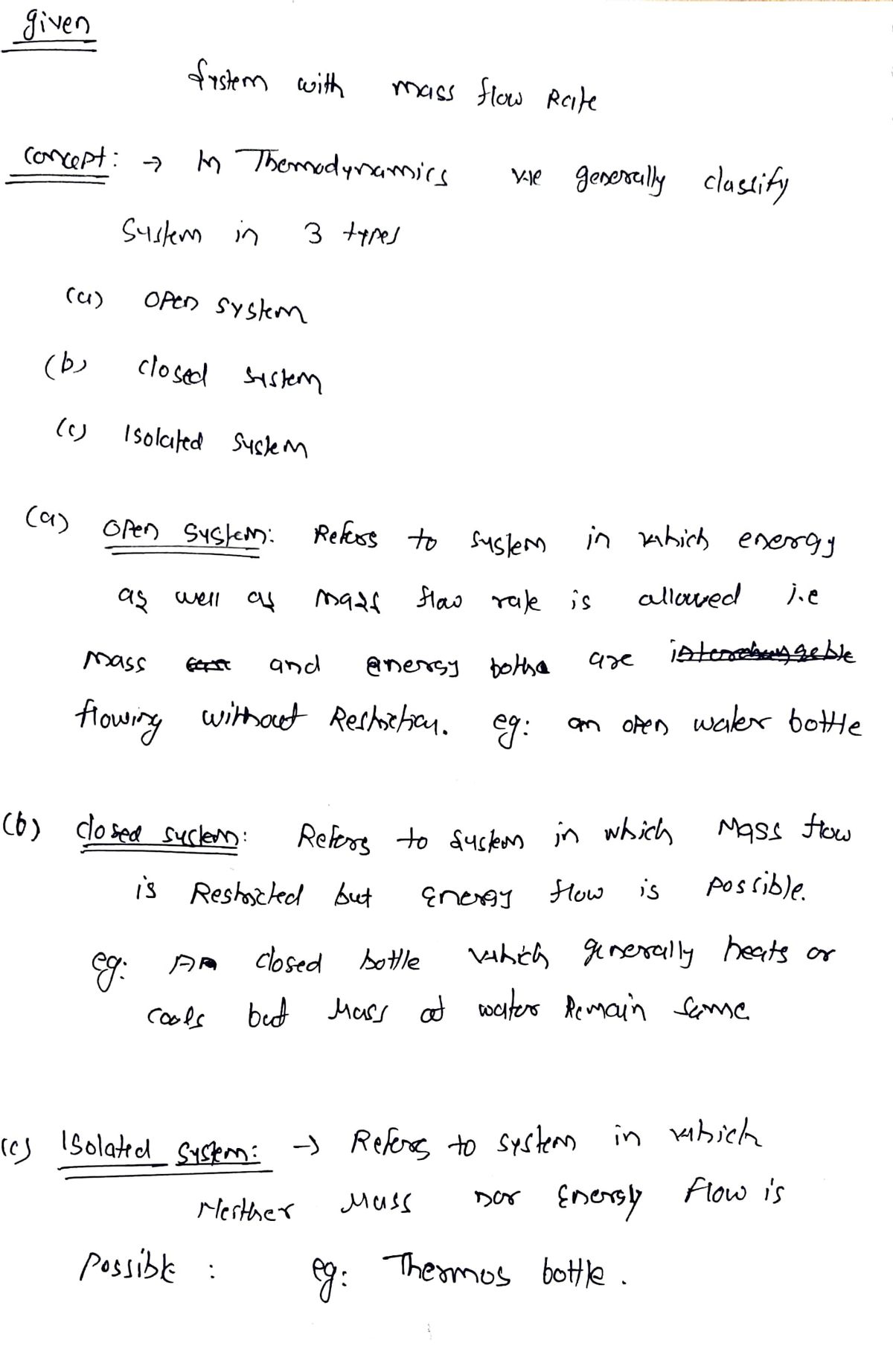
Elements Of Electromagnetics
7th Edition
ISBN: 9780190698614
Author: Sadiku, Matthew N. O.
Publisher: Oxford University Press
expand_more
expand_more
format_list_bulleted
Concept explainers
Question
-
For a given system, if a mass flow exits, then what is the system ______
A. open system
B. closed system
C. either open or closed
D. none of them
Expert Solution
arrow_forward
Step 1

Step by stepSolved in 2 steps with 2 images

Knowledge Booster
Learn more about
Need a deep-dive on the concept behind this application? Look no further. Learn more about this topic, mechanical-engineering and related others by exploring similar questions and additional content below.Similar questions
- The figure shows data for a portion of the ducting in a ventilation system operating at steady state. The ducts are well insulated and the pressure is very nearly 1 atm throughout. The volumetric flow rate entering at state 2 is AV₂2 = 4400 ft3/min. Assume the ideal gas model for air with cp = 0.24 Btu/lb-ºR and ignore kinetic and potential energy effects. 1 (AV)1 = 5000 ft³/min T₁ = 80°F (AV)₂ T₂ = 40°F ft³/min Air, Cp=0.24 Btu/lb R p=1 atm -Insulation 3 V3=400 ft/min T3 = ? Determine the temperature of the air at the exit, in °F, and the rate of entropy production within the ducts, in Btu/min.°R.arrow_forwardI need questions d and earrow_forwardSteam Transmission Liquid (c) When the steam in the piston-cylinder assembly expands, the transmission converts the piston motion to rotary motion of a paddlewheel that stirs a viscous liquid. The principal source of irreversibility isarrow_forward
- As shown in the figure, Refrigerant 22 enters the compressor of an air conditioning unit operating at steady state at 40°F, 80 lb;/in? and is compressed to 160°F, 200 Ib;/in?. The refrigerant exiting the compressor enters a condenser where energy transfer to air as a separate stream occurs, and the refrigerant exits as a liquid at 200 Ib:/in?, 90°F. Air enters the condenser at 70°F, 14.7 lb:/in? with a volumetric flow rate of 750 ft/min and exits at 110°F. Neglect stray heat transfer and kinetic and potential energy effects, and assume ideal gas behavior for the air. Condenser Air at T P4=14.7 1bf'in.? (AV), 5 4 wwww T I; =110°F 3 p2 = p3 = 200 ib/in = 60°F T,= 160°F P2= 200 lbfin. T3- 90'F P=200 Ibf/in2 T3 = 90°F pi = 80 lbrin? T1 Compressor = 40°F 1+ R22 at Iz = 40°F Pi - 80 Ibf/in.? Determine the mass flow rate of refrigerant, in Ib/min, and the compressor power, in horsepower.arrow_forwardAir enters a diffuser operating at steady state at 540°R, 15 Ilbf/in.?, with a velocity of 600 ft/s, and exits with a velocity of 60 ft/s. The ratio of the exit area to the inlet area is 6. Assuming the ideal gas model for the air and ignoring heat transfer, determine the temperature, in °R, and pressure, in Ibf/in.?, at the exit.arrow_forwardNeed Help going through the process on how to solve this problem. May accidentally be asking this a second time, because the first time I asked it, it didn't show as a pending problem. Steam expands adiabatically through a turbine at steady state. The entering stream is at 750 lbf/in^2, 750°F, and the exiting stream is a saturated vapor at 10 lbf/in^2. Kinetic and potential energy effects are negligible. a. How much work per lb of flow does the turbine produce, in Btu/lbm? b. If the turbine produces 3000 kW of output power, determine the mass flow rate of steam in kg/s. c. If this process were isentropic, the existing stream would no longer be a saturated vapor. Determine the final quality of steam in that case. d. Determine the isentropic turbine efficiency.arrow_forward
arrow_back_ios
arrow_forward_ios
Recommended textbooks for you
 Elements Of ElectromagneticsMechanical EngineeringISBN:9780190698614Author:Sadiku, Matthew N. O.Publisher:Oxford University Press
Elements Of ElectromagneticsMechanical EngineeringISBN:9780190698614Author:Sadiku, Matthew N. O.Publisher:Oxford University Press Mechanics of Materials (10th Edition)Mechanical EngineeringISBN:9780134319650Author:Russell C. HibbelerPublisher:PEARSON
Mechanics of Materials (10th Edition)Mechanical EngineeringISBN:9780134319650Author:Russell C. HibbelerPublisher:PEARSON Thermodynamics: An Engineering ApproachMechanical EngineeringISBN:9781259822674Author:Yunus A. Cengel Dr., Michael A. BolesPublisher:McGraw-Hill Education
Thermodynamics: An Engineering ApproachMechanical EngineeringISBN:9781259822674Author:Yunus A. Cengel Dr., Michael A. BolesPublisher:McGraw-Hill Education Control Systems EngineeringMechanical EngineeringISBN:9781118170519Author:Norman S. NisePublisher:WILEY
Control Systems EngineeringMechanical EngineeringISBN:9781118170519Author:Norman S. NisePublisher:WILEY Mechanics of Materials (MindTap Course List)Mechanical EngineeringISBN:9781337093347Author:Barry J. Goodno, James M. GerePublisher:Cengage Learning
Mechanics of Materials (MindTap Course List)Mechanical EngineeringISBN:9781337093347Author:Barry J. Goodno, James M. GerePublisher:Cengage Learning Engineering Mechanics: StaticsMechanical EngineeringISBN:9781118807330Author:James L. Meriam, L. G. Kraige, J. N. BoltonPublisher:WILEY
Engineering Mechanics: StaticsMechanical EngineeringISBN:9781118807330Author:James L. Meriam, L. G. Kraige, J. N. BoltonPublisher:WILEY

Elements Of Electromagnetics
Mechanical Engineering
ISBN:9780190698614
Author:Sadiku, Matthew N. O.
Publisher:Oxford University Press

Mechanics of Materials (10th Edition)
Mechanical Engineering
ISBN:9780134319650
Author:Russell C. Hibbeler
Publisher:PEARSON

Thermodynamics: An Engineering Approach
Mechanical Engineering
ISBN:9781259822674
Author:Yunus A. Cengel Dr., Michael A. Boles
Publisher:McGraw-Hill Education

Control Systems Engineering
Mechanical Engineering
ISBN:9781118170519
Author:Norman S. Nise
Publisher:WILEY

Mechanics of Materials (MindTap Course List)
Mechanical Engineering
ISBN:9781337093347
Author:Barry J. Goodno, James M. Gere
Publisher:Cengage Learning

Engineering Mechanics: Statics
Mechanical Engineering
ISBN:9781118807330
Author:James L. Meriam, L. G. Kraige, J. N. Bolton
Publisher:WILEY